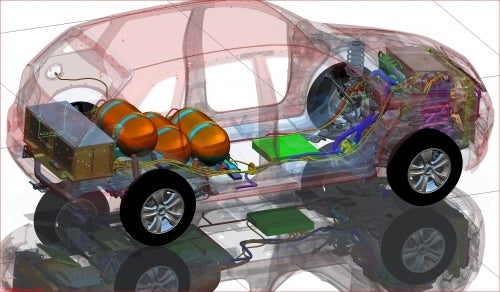If you would like to see more information on this case study, click here!
You can request this case study and a WCDE staff member will get back to you.
The University of Waterloo Alternative Fuels Team, UWAFT, has a mission to design, build, and market fuel efficient vehicles of the future. UWAFT was one of 16 university student teams participating in EcoCAR: The NeXt Challenge. The challenge was established by the USA Department of Energy and General Motors (GM), recognizing the need to devise solutions to reduce the environmental impact of gasoline-fueled vehicles. Students are challenged with re-engineering a GM-donated vehicle, a dual-mode hybrid Saturn VUE. The overall objective is to significantly reduce fuel consumption and emissions by exploring advanced technological solutions, while increasing energy efficiency and maintaining vehicle performance, safety and utility. Vehicle configurations considered by the various teams include electric drive (EV), hybrid, plug-in hybrid (PHV) and fuel cell (FCV) technologies. Alternate fuels range from ethanol, biodiesel and hydrogen. All teams explored alternative lightweight materials.
The UWAFT team chose a hybrid electric vehicle architecture, which relies on a suitably sized battery pack, Figure 1. They chose a system suitable for the competition requirements and readily available from one of the competition sponsors, it is desired to examine the possibility of an alternate system more suited to typical consumer use.
 University of Waterloo Powertrain Configuration for the EcoCAR
University of Waterloo Powertrain Configuration for the EcoCAR
The learning objective for this case study is to introduce 1st year engineering undergraduate students to engineering design concepts. It can also be used in many other courses throughout the curriculum to illustrate the application of advanced engineering science concepts including battery performance, motor control, hybrid vehicle control, material selection and light-weighting, and fuel cell technology
If you would like to see more information on this case study, click here!
You can request this case study and a WCDE staff member will get back to you.
Contact Waterloo Cases in Design Engineering
Steve Lambert
Tel: (519) 888-4728
Email: steve@uwaterloo.ca
The University of Waterloo acknowledges that much of our work takes place on the traditional territory of the Neutral, Anishinaabeg, and Haudenosaunee peoples. Our main campus is situated on the Haldimand Tract, the land granted to the Six Nations that includes six miles on each side of the Grand River. Our active work toward reconciliation takes place across our campuses through research, learning, teaching, and community building, and is co-ordinated within the Office of Indigenous Relations.